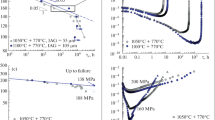Abstract
The creep properties of niobium-stabilised stainless steels of carbon contents in the range 0.01 to 0.05% carbon can be accounted for by the general recovery theory of creep. The high stress dependencies of recovery and creep rate can be adequately explained through an internal friction stress or impedance term, retarding recovery. Measurement of this friction term by dislocation density and stress relaxation techniques provides the correct stress dependencies when applied to the modified recovery theory.
Similar content being viewed by others
References
R. W. Bailey,J. Inst. Metals 35 (1926) 27.
E. Orowan,J. West Scotland Iron & Steel Inst. 54 (1946–47) 45.
A. H. Cottrell andV. Aytekin,J. Inst. Metals 77 (1950) 389.
D. Mclean andK. F. Hale, Structural processes in Creep,Iron and Steel Inst. Spec. Report (1961) p. 19.
D. McLean,Reports Progr. Phys. 29 (1966) 1.
Y. Ishida andD. McLean,J. Iron & Steel Inst. 205 (1967) 88.
D. McLean,Trans. Met. Soc. AIME 242 (1968) 1193.
P. W. Davies andK. R. Williams,Acta Metallurgica 17 (1969) 897.
Idem, J. Inst. Metals 97 (1969) 337.
W. J. Evans andB. Wilshire,Trans. Met. Soc. AIME 242 (1968) 2514.
T. Watanabe andS. Karashima, Paper presented at Int. Conf. on the Strength of Metals and Alloys, Tokyo, 1967.
D. Sidey andB. Wilshire,Metal Sci. J. 3 (1969) 56.
J. Friedel, “Dislocations” (Pergamon Press, London, 1964).
M. Hillert,Acta Metallurgica 13 (1965) 227.
R. Lagneborg,J. Mater. Sci. 3 (1968) 596.
H. Weidersich,J. Metals 16 (1964) 425.
G. B. Gibbs,Phil. Mag. 13 (1966) 317.
C. M. Ahlquist andW. D. Nix,Scripta Met. 3 (1969) 679.
P. B. Hirsch, A. Howie, R. B. Nigholson, D. W. Pashley, andM. J. Whelan, “Electron Microscopy of Thin Crystals” (Butterworths, London, 1965) p. 415.
A. F. Rowcliffe,J. Inst. Metals 94 (1966) 263.
R. Lagneborg,Metal Sci. J. 3 (1969) 18.
B. Russel, R. K. Ham, J. M. Silcock, andG. Willoughby,ibid 2 (1968) 201.
G. A. Sargeant,Acta Metallurgica 13 (1965) 663.
D. Hull, “Introduction to Dislocations” (Pergamon Press 1965) p. 224.
C. R. Barrett andW. D. Nix,Acta Metallurgica 13 (1965) 1247.
S. K. Mitra andD. McLean,Metal Sci. J. 1 (1967) 192.
Author information
Authors and Affiliations
Rights and permissions
About this article
Cite this article
Williams, K.R., McLauchlin, I.R. The recovery creep of niobium-stabilised austenitic stainless steels. J Mater Sci 5, 1063–1072 (1970). https://doi.org/10.1007/BF02403279
Received:
Accepted:
Issue Date:
DOI: https://doi.org/10.1007/BF02403279




